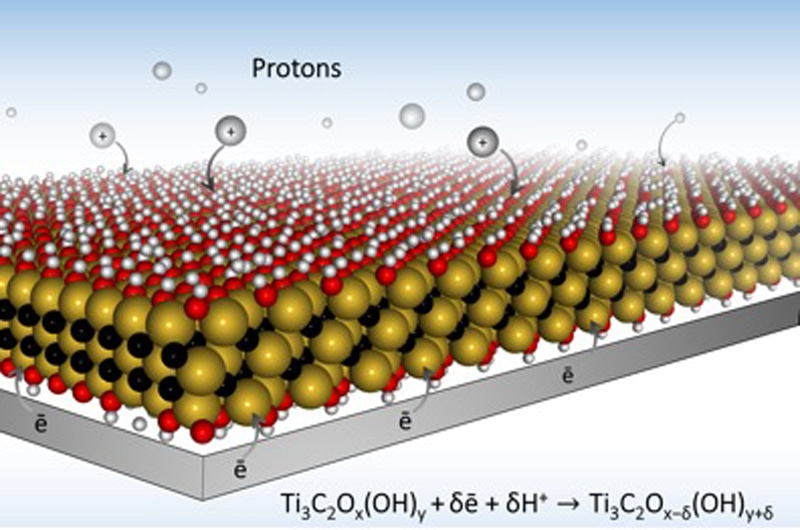Jul 11 2017
Imagine fully charging a cell phone in just a few seconds. Now, Researchers from Drexel University’s College of Engineering have moved a big step forward in making this reality with their latest work unveiling of a new battery electrode design in the Nature Energy journal.
 Drexel researchers developed electrode designs using MXene that allow for much faster charging because they open up paths for ions to quickly travel within the material. Credit: Drexel University
Drexel researchers developed electrode designs using MXene that allow for much faster charging because they open up paths for ions to quickly travel within the material. Credit: Drexel University
The group, headed by Yury Gogotsi, PhD, Distinguished University and Bach Professor in Drexel’s College of Engineering, in the Department of Materials Science and Engineering, developed the new electrode designs from a two-dimensional, highly conductive material called MXene. Their design could help make energy storage devices, such as batteries, viewed as the plodding tanker truck of energy storage technology, just as quick as the speedy supercapacitors that are used to deliver energy in a pinch, often as a battery back-up or to deliver quick bursts of energy for things like camera flashes.
This paper refutes the widely accepted dogma that chemical charge storage, used in batteries and pseudocapacitors, is always much slower than physical storage used in electrical double-layer capacitors, also known as supercapacitors. We demonstrate charging of thin MXene electrodes in tens of milliseconds. This is enabled by very high electronic conductivity of MXene. This paves the way to development of ultrafast energy storage devices than can be charged and discharged within seconds, but store much more energy than conventional supercapacitors.
Yury Gogotsi, PhD, Distinguished University and Bach Professor, Drexel’s College of Engineering
The key to fast-charging energy storage devices is in the electrode design. Electrodes are vital components of batteries, through which energy is stored at the time of charging and from which it is distributed to power electronic devices. Therefore, the perfect design for these components would be one that enables them to be rapidly charged and store more energy.
In order to store more energy, the materials must have places to put it. Electrode materials present in batteries provide ports for charge to be stored. These ports are called “redox active sites” in electrochemistry, and they hold an electrical charge when each ion is delivered. Therefore, if the electrode material has more ports, it can store more energy — which connects to a battery with more “juice.”
Partners Zifeng Lin and Patrice Simon, PhD, from Université Paul Sabatier in France, created a hydrogel electrode design with more redox active sites, which enables it to store as much charge for its volume as a battery. This capacity measure, called “volumetric performance,” is a vital metric for judging the utility of various energy storage devices.
In order to make hydrogel electrode ports more attractive to ion traffic, the Drexel-led group, including investigators Maria Lukatskaya, PhD, Sankalp Kota, a Graduate Student in Drexel’s MAX/MXene Research Group headed by Michel Barsoum, PhD, Distinguished Professor in the College of Engineering; and Mengquiang Zhao, PhD, designed electrode architectures with open macroporosity, many small openings, in order to make each redox active sites in the MXene material easily accessible to ions.
In traditional batteries and supercapacitors, ions have a tortuous path toward charge storage ports, which not only slows down everything, but it also creates a situation where very few ions actually reach their destination at fast charging rates. The ideal electrode architecture would be something like ions moving to the ports via multi-lane, high-speed ‘highways,’ instead of taking single-lane roads. Our macroporous electrode design achieves this goal, which allows for rapid charging — on the order of a few seconds or less.
Maria Lukatskaya, the First Author on the paper, who conducted the research as part of the A.J. Drexel Nanomaterials Institute
The overarching advantage of using MXene as the material for the electrode design is its conductivity. Materials that enable rapid flow of an electrical current, like copper and aluminum, are often used in electric cables. Just like metals, MXenes are conductive, therefore, not only do ions have a wide-open path to a range of storage ports, but they can also move very rapidly to meet electrons there. Netanel Shpigel and Mikhael Levi, PhD, Research Partners from Bar-Ilan University in Israel, assisted the Drexel team to increase the number of the ports available to ions in MXene electrodes.
The use of the MXene material in battery electrodes is just the latest in a series of developments. This was discovered in 2011 by Scientists in Drexel’s Department of Materials Science and Engineering. Since then, Scientists have been testing them in a number of applications from energy storage to water filtering, and electromagnetic radiation shielding. This latest development is particularly important because it tackles one of the key problems the hinder the expansion of the electric vehicle industry and that has been lurking on the horizon for mobile devices.
If we start using low-dimensional and electronically conducting materials as battery electrodes, we can make batteries working much, much faster than today. Eventually, appreciation of this fact will lead us to car, laptop and cell-phone batteries capable of charging at much higher rates — seconds or minutes rather than hours.
Yury Gogotsi, PhD, Distinguished University and Bach Professor, Drexel’s College of Engineering
This research was supported by Fluid Interface Reactions, Structures and Transport (FIRST) Center, an Energy Frontier Research Center funded by the U.S. Department of Energy’s Office of Science and Office of Basic Energy Sciences; as well as the National Science Foundation and Binational Science Foundation, which supported collaborations with France and Israel, respectively.